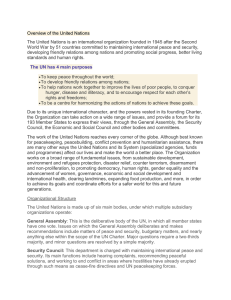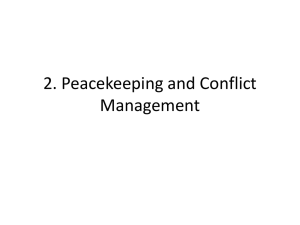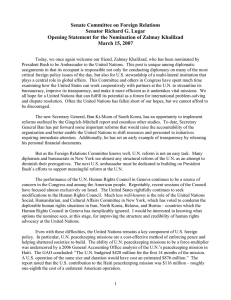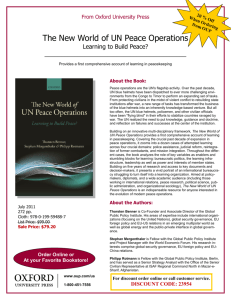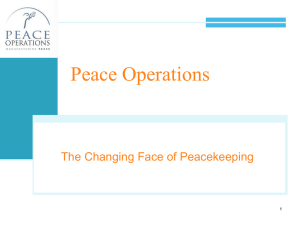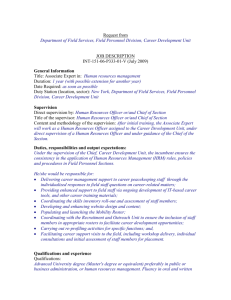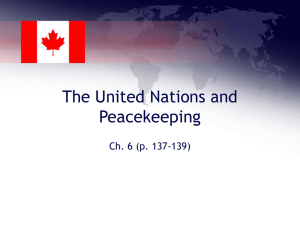GAO
advertisement
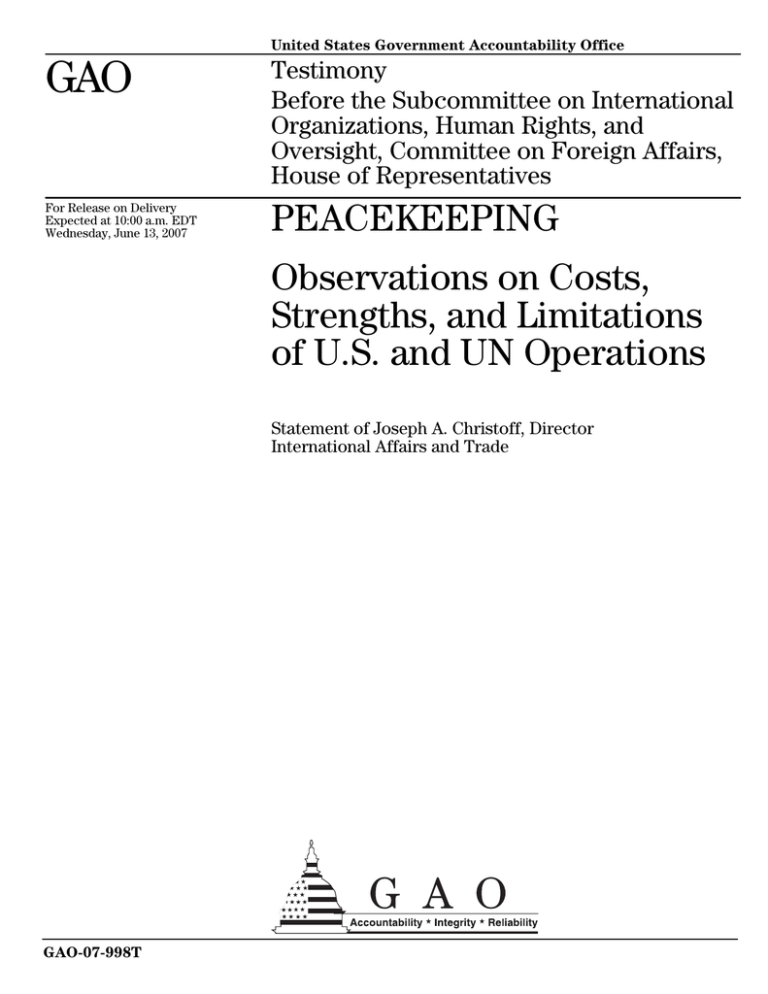
United States Government Accountability Office GAO Testimony Before the Subcommittee on International Organizations, Human Rights, and Oversight, Committee on Foreign Affairs, House of Representatives For Release on Delivery Expected at 10:00 a.m. EDT Wednesday, June 13, 2007 PEACEKEEPING Observations on Costs, Strengths, and Limitations of U.S. and UN Operations Statement of Joseph A. Christoff, Director International Affairs and Trade GAO-07-998T June 2007 PEACEKEEPING Accountability Integrity Reliability Highlights Highlights of GAO-07-998T, a testimony before the Subcommittee on International Organizations, Human Rigths, and Oversight, Committee on Foreign Affairs, House of Representatives Why GAO Did This Study As of June 2007, more than 100,000 military and civilian personnel are engaged in UN peacekeeping operations in 15 locations in Africa, Europe, Asia, the Americas, and the Middle East. In 2006, the United States provided the UN with about $1 billion to support peacekeeping operations. Given that thousands of U.S. troops are intensively deployed in combat operations in Iraq and Afghanistan, UN peacekeeping operations are an important element in maintaining a secure international environment. As requested, this testimony discusses (1) the costs of the current UN mission in Haiti compared with the estimated cost of a hypothetical U.S. operation and (2) the strengths and limitations of the United States and the UN in leading peace operations. This testimony is based on our prior report and information we updated for this hearing. To estimate U.S. costs, we developed parameters for a U.S. mission similar to the UN mission in Haiti, which the Joint Staff validated as reasonable. We then applied DOD’s official cost estimating model. However, it is uncertain whether the United States would implement an operation in Haiti in the same way as the UN. Observations on Costs, Strengths, and Limitations of U.S. and UN Operations What GAO Found We estimate that it would cost the United States about twice as much as it would the UN to conduct a peacekeeping operation similar to the UN mission in Haiti. The UN budgeted $428 million for the first 14 months of the mission. A similar U.S. operation would have cost an estimated $876 million. Virtually the entire cost difference can be attributed to cost of civilian police, military pay and support, and facilities. First, civilian police costs are less in a UN operation because the UN pays police a standard daily allowance, while U.S. police are given salaries, special pay, and training. Second, U.S. military pay and support reflect higher salaries and higher standards for equipment, ammunition, and rations. Third, U.S. facilities-related costs would be twice those of the UN and reflect the cost of posting U.S. civilian personnel in a secure embassy compound. When we varied specific factors, such as increasing the number of reserve troops deployed, the estimated cost for a U.S. operation increased. Cost is not the sole factor in determining whether the United States or the UN should lead a peacekeeping operation. Each offers strengths and limitations. Traditionally, the United States’ strengths have included rapid deployment, strong command and control, and well-trained and equipped personnel. However, ongoing operations in Iraq and Afghanistan have reduced personnel and equipment readiness levels and resulted in shortfalls for military police, engineers, and civil affairs experts. The UN provides broad multinational support for its missions, with a UN Security Council mandate and direction for its operations. The UN also has access to international civil servants, police, and senior officials who have nationbuilding experience and diverse language skills. Finally, the UN has fostered a network of agencies and development banks to coordinate international assistance with peacekeeping missions. However, the UN has traditionally had difficulties in rapidly deploying its forces and ensuring unified command and control over its peacekeeping forces. Cost Estimate for a U.S. Operation and UN MINUSTAH Budget www.gao.gov/cgi-bin/getrpt?GAO-07-998T. To view the full product, including the scope and methodology, click on the link above. For more information, contact Joseph A. Christoff at (202) 512-8979 or christoffj@gao.gov. United States Government Accountability Office Mr. Chairman and Members of the Subcommittee: I am pleased to be here today to discuss the results of the work we completed for this subcommittee on the cost of a United Nations (UN) peacekeeping operation versus the cost of a similar U.S. operation. As of May 2007, more than 100,000 military and civilian personnel are engaged in UN peacekeeping operations in 15 locations in Africa, Europe, Asia, the Americas, and the Middle East. In 2006, the United States provided the UN with about $1 billion to support peacekeeping operations out of a total peacekeeping budget of about $5.5 billion. Given that U.S. troops are intensively deployed in combat operations in Iraq and Afghanistan, UN peacekeeping operations are a key element in maintaining a secure international environment. My testimony today focuses on (1) the costs of the current UN mission in Haiti compared with the estimated cost of a hypothetical U.S. operation and (2) the strengths and limitations of the United States and the UN in leading peace operations. This testimony is based on our prior report1 and information we updated for this hearing. We reviewed classified and unclassified information, but we used only unclassified information in this statement. We selected the UN mission in Haiti as a case study because both the United States and the UN have conducted operations in that country, thus providing comparative information on their two approaches. However, it is uncertain whether the United States would implement an operation in Haiti in the same way as the UN, given operational, structural, and doctrinal differences. While the results of the review cannot be generalized to other U.S. and UN operations, we believe this report provides useful insights into the costs and effectiveness of unilateral and multilateral peacekeeping missions. To compare UN and U.S. costs to implement a comparable peacekeeping operation, we obtained budget data for the first 14 months of the UN Stabilization Mission in Haiti (MINUSTAH). We developed a scenario for a U.S. operation in Haiti that used the same deployment schedule as the UN, with the same number of military, civilian, and police personnel and aircraft over the same period. Officials from the Joint Staff validated this scenario as reasonable. We used DOD’s Contingency Operation Support Tool to estimate military costs. DOD requires that this model be used to 1 GAO, Peacekeeping: Cost Comparison of Actual UN and Hypothetical U.S. Operations in Haiti, GAO-06-331 (Washington, D.C.: Feb. 21, 2006). Page 1 GAO-07-998T generate estimates for all U.S. contingency operations, and it is used as the basis for the supplemental appropriation requests to Congress.2 To estimate civilian costs, we used historical data and formulas from the Department of State. To assess the relative strengths and limitations of U.S. and UN forces, we analyzed UN and U.S. reports, including information on UN- and U.S.-led operations in Haiti, Iraq, and Afghanistan. We interviewed officials from DOD and State to get their perspectives on the strengths and limitations of UN- and U.S.-led operations. We conducted our work in accordance with generally accepted government auditing standards. Summary We estimate that it would cost the United States about twice as much as it would the UN to conduct a peacekeeping operation similar to the UN mission in Haiti. The UN budgeted $428 million for the first 14 months of the mission, of which the United States was responsible for $116 million. A similar U.S. operation would have cost an estimated $876 million. Virtually the entire cost difference can be attributed to three major elements: civilian police, military pay and support, and facilities. First, the estimated cost of deploying U.S. civilian police is $217 million or about 8 times the $25 million budgeted by the UN for international police officers. Compensation rates for U.S. police include higher costs for salaries, special pay and training, whereas the UN pays police a standard daily allowance. Second, we estimated that U.S. military pay and support would cost $260 million, compared with $131 million in the UN budget, and reflects higher salaries and higher standards for equipment, ammunition, and rations. Third, U.S. facilities-related costs would be twice those of the UN, reflecting the cost of posting U.S. civilian personnel in a secure embassy compound. Several factors could affect the estimated costs of a U.S. operation, including the mix of reserve and active duty troops and the rate of troop deployment. When we varied these factors—for example, by increasing the number of reserve troops deployed—the estimated cost for a U.S. operation increased. Cost is not the sole factor in determining whether the United States or the UN should lead a peacekeeping operation. Each offers strengths and limitations. Traditionally, the United States’ strengths have included rapid deployment, strong command and control, and well-trained and equipped 2 Department of Defense Financial Management Regulations, 7000.14-R, vol. 12, Ch. 23, para. 2304. Page 2 GAO-07-998T personnel. However, ongoing operations in Iraq and Afghanistan have reduced personnel and equipment readiness levels and resulted in shortfalls for military police, engineers, and civil affairs experts. The UN provides broad multinational support for its missions, with a UN Security Council mandate and direction for its operations. The UN also has access to international civil servants, police, and senior officials who have nationbuilding experience and diverse language skills. Finally, the UN has fostered a network of agencies and development banks to coordinate international assistance with peacekeeping missions. However, the UN has traditionally had difficulties in rapidly deploying its forces and ensuring unified command and control over its peacekeeping forces. Background Both the UN and United States have a long history of conducting operations to promote peace and stability. The UN has undertaken more than 60 peacekeeping missions since 1948 and states that it has negotiated more than 170 settlements that have ended regional conflicts. As of June 2007, 15 UN peacekeeping operations were ongoing in Africa, Europe, the Middle East, Asia, and the Americas.3 As shown in figure 1, the number of military troops and police in UN peacekeeping operations has steadily increased from 29,140 personnel in 1996 to 83,071 in 2007, with a record number of peacekeepers deployed around the world by March 2007. The United States has led and participated in many peacekeeping operations, such as in Somalia, Haiti, and the Balkans; as of April 2007, there were 310 U.S. military and police serving in UN operations. In contrast to the relatively few U.S. troops and police in UN operations, the United States has about 146,000 troops in Iraq and about 25,000 in Afghanistan in stability operations as of April 2007. 3 Ongoing UN Peacekeeping Operations as of June 2007 include missions in Jerusalem, India/Pakistan, Cyprus, Syria, Lebanon, Western Sahara, Georgia, Kosovo, Democratic Republic of Congo, Ethiopia/Eritrea, Liberia, Côte D’Ivoire, Haiti, Sudan, and Timor-Leste. Political missions supported by DPKO include missions in Afghanistan, Sierra Leone, and Burundi. Page 3 GAO-07-998T Figure 1: UN Military and Police Deployed to Peacekeeping Missions Number of Peacekeepers (in thousands) 90 80 70 60 50 40 30 20 10 0 1996 1997 1998 1999 2001 2000 2002 2003 2004 2005 2006 2007 (March) Calendar year Source: GAO analysis of UN data. The United States is the largest financial contributor to UN peacekeeping, with payments of more than $1 billion in 2006. In total, the United States pays 25 percent or more of the annual peacekeeping budget. (Figure 2 provides information about U.S. contributions to UN peacekeeping.) The UN annually assesses the United States about 26 percent of the UN peacekeeping budget (including higher percentages before 2006). However, U.S. legislation capped payments in 1995 at 25 percent, resulting in arrears. Congress has lifted the cap for some years.4 According to the Department of State, the amount of U.S. arrears for UN peacekeeping since 2005 is $117 million. This amount reflects arrears as of June 2007. In addition, the United States, as a permanent member of the UN Security Council, approved many UN peacekeeping missions and activities prior to 2005. According to the Department of State, U.S. arrears for these peacekeeping efforts total $505 million, but State does not have legal authority to pay for them. 4 The cap level changed in 2001 due to legislation and remained at around 27 percent from 2001 to 2005. The cap returned to 25 percent in 2006. Page 4 GAO-07-998T Figure 2: U.S. Payments for UN Peacekeeping Since 1993, the UN has maintained a nearly constant peacekeeping presence in Haiti to help stabilize the country, combat crime, and support elections (see figure 3). Since 1994, the United States has led two military interventions and one humanitarian mission to help stabilize the country. The primary task of the current UN mission in Haiti is to provide a secure and stable environment, assist the transitional government with Haiti’s political processes, protect human rights, and support the Haitian National Police. Authorization for the mission is set to expire in October 2007, but the UN Security Council has renewed MINUSTAH’s mandate since 2004. UN reports cite MINUSTAH’s role in attempting to create a relatively stable security environment in most of the country. However, the overall situation is still volatile and sporadic armed violence continues. Page 5 GAO-07-998T Figure 3: U.S. and UN Operations in Haiti Uphold Democracy U.S. Secure Tomorrow New Horizons Present 1992 U.N. 1993 UNMIH 1994 1995 1996 1997 UNMIH UNSMIH UNTMIH 1998 1999 2000 2001 MIPONUH Legend UNMIH - United Nations Mission in Haiti Uphold Democracy - Operation Uphold Democracy UNMIH - United Nations Mission in Haiti UNSMIH - United Nations Support Mission in Haiti UNTIMIH - United Nations Transition Mission in Haiti MIPONUH - United Nations Civilian Police Mission in Haiti Secure Tomorrow - Operation Secure Tomorrow MINUSTAH - United Nations Stabilization Mission in Haiti New Horizons - Operation New Horizons 2002 2003 2004 2005 MINUSTAH September 1993 - October 1993 September 1994 - March 1995 March 1995 - June 1996 July 1996 - July 1997 August 1997 - November 1997 December 1997 - March 2000 February 2004 - June 2004 June 2004 - Present February 2005 - May 2005 Source: GAO analysis of UN and DOD data. Note: Operations Uphold Democracy and Secure Tomorrow were military interventions to provide security in Haiti and restore government control. Operation New Horizons was a humanitarian mission to develop infrastructure and provide medical and dental services. The UN has spent about $891 million from the inception of MINUSTAH in 2004 to June 2006. For the UN’s current fiscal year for peacekeeping, ending June 30, 2007, the UN budgeted about $491 million. (See table 1 for details on budgeted and actual UN expenditures for MINUSTAH.) The current budget of $491 provides for 7,500 military personnel, 1,000 police in formed units, 897 civilian police, and 1,771 civilian officials and staff. Table 1: Budgeted and Actual UN Expenditures for MINUSTAH (U.S. Dollars) Fiscal year of MINUSTAH operations Budgeted by UN Expended by UN 05/01/04 to 06/30/04 $49,259,800 $34,556,100 07/01/04 to 06/30/05 $379,046,800 $377,235,300 Total for first 14 months of operation $428,306,600 $411,791,400 07/01/05 to 06/30/06 $516,488,500 $479,636,600 07/01/06 to 06/30/07 Total cost for MINUSTAH $490,636,200 N/A $1,435,431,300 $891,428,000 Source: GAO analysis of UN budgetary data. Page 6 GAO-07-998T Estimated Costs for a U.S. Operation Are at Least Twice the Cost of a Similar UN Mission We estimate that it would cost the United States about twice as much as it would the UN to conduct an operation similar to the UN mission in Haiti. Virtually the entire difference is attributable to the higher cost of civilian police, military pay and support, and facilities. The difference also reflects the additional cost of ensuring high U.S. standards for training, troop welfare, and personnel security. If the United States were to deploy a higher percentage of reserves rather than active duty troops, deploy more quickly, or operate at a higher intensity, U.S. costs would be higher. Estimated U.S. Costs Are Higher in Major Categories From May 1, 2004, to June 30, 2005—the first 14 months of MINUSTAH— the UN budgeted costs for the operation totaled $428 million.5 This budget assumed a phased deployment of 6,700 military personnel, 750 police in formed units, 872 civilian police officers, and 1,184 civilian administrators and staff. It also included the cost of operational support, equipment, facilities, and transportation.6 Financial responsibilities of the U.S. for MINUSTAH for the first 14 months were about $116 million. Using the same basic parameters of troop and staff deployment in Haiti for 14 months, we estimate that a comparable U.S. operation would cost about $876 million, slightly more than twice as much as the UN. Table 2 details the differences between the UN and a hypothetical U.S. operation in major cost categories. 5 For a detailed discussion of the methodology used to construct the U.S. operation cost estimate and alternate scenario cost estimates, see appendix I of Peacekeeping: Cost Comparison of Actual UN and Hypothetical U.S. Operations in Haiti, GAO-06-331 (Washington, D.C.: Feb. 21, 2006). 6 The UN cost estimate does not include the general overhead costs incurred to support all peacekeeping missions, such as the costs of running the Department of Peacekeeping Operations at the UN headquarters in New York and the UN logistics base in Brindisi, Italy. We likewise did not include DOD overhead costs in the U.S. operation estimate. Page 7 GAO-07-998T Table 2: UN and U.S. Costs for a Peacekeeping Operation in Haiti (U.S. dollars in millions) Major cost categories Budgeted Estimated Difference between UN UN cost U.S. cost budget and U.S. estimate Transportation $94 $100 -$6 Facilities and related costs 100 208 -108 Medical/health costs Military personnel pay and support 5 22 -17 131 260 -129 Civilian personnel (non-police) 63 46 17 Civilian police 25 217 -192 Miscellaneous 10 23 -13 $428 $876 -$448 Total cost Source: GAO analysis of DOD and State Department cost data. As table 2 illustrates, the costs for civilian police, military pay and support, and facilities account for most of the difference between the two operations. These differences are explained below. • Civilian police. The UN budgeted $25 million to deploy 872 civilian officers for MINUSTAH, while we estimate that it would cost the United States $217 million to deploy the same number of civilian U.S. police officers. The UN provides a daily allowance for police and does not reimburse countries contributing police for the officers’ salaries. U.S. costs, however, include salaries, special pay, benefits, equipment, and special training. • Military pay and support. The UN budgeted $131 million for pay and support of military troops, while we estimate it would cost the United States $260 million for the same number of soldiers. The UN costs are based on a monthly payment of up to $1,400 per soldier to contributing nations for basic pay and allowances, clothing, equipment, and ammunition. U.S. costs include pay and allowances for troops, as well as clothing, arms, protective gear, and rations. U.S. costs provide a higher standard of living for U.S. soldiers and higher standards for equipment, nutrition, health, and morale. • Facilities. The UN budgeted $100 million for facilities-related costs, while we estimate that the cost to the United States would be $208 million. The UN budget includes acquisition and construction of troop and civilian housing and equipment and supplies. U.S. facilities must meet State Department security standards, which include posting civilian staff within secure U.S. embassy or consulate compounds. Also, U.S. agencies with Page 8 GAO-07-998T staff in these compounds would be required to contribute to State’s Capital Security Cost-Sharing Program.7 Alternative Military Assumptions Generated Higher U.S. Cost Estimates According to U.S. experts, changes in the underlying planning factors significantly affect the estimated cost of a U.S. operation. Based on consultations with the joint staff officials and other experts, we analyzed how the cost of a U.S. operation would vary if we (1) changed the mix of active duty to reserve soldiers from 85 percent active to an entirely reserve force, (2) assumed U.S. forces would fully deploy within 60 rather than 180 days, and (3) increased the intensity of the operation. As figure 4 shows, each of these changes increased the estimated costs for a U.S. operation. 7 The Capital Security Cost-Sharing Program was developed to accelerate the building of 150 new secure embassies and consulates around the world and to ensure that all agencies with overseas staff assign only the number of staff needed to accomplish their overseas missions. Each agency’s assigned cost is based on its total overseas personnel. See Pub. L. No. 108-447, 118 Stat. 2809, 2920, Div. B., sec. 629 (2004). See also GAO, Embassy Construction: Proposed Cost-Sharing Program Could Speed Construction and Reduce Staff Levels, but Some Agencies Have Concerns, GAO-05-32 (Washington, D.C.: Nov. 15, 2004). Page 9 GAO-07-998T Figure 4: Impact of Three Cost Factors on Base Estimate for a Hypothetical U.S. Operation Specifically, the changes resulted in these increases in each category: • By deploying an all reserve force, the estimated U.S. cost would increase by $477 million. The increase is because DOD must begin to pay full active duty military salaries to reservists when they are activated for an operation. Officials from the Joint Chiefs of Staff confirmed that this is one of a number of possible scenarios of a U.S. operation. • By fully deploying U.S. troops in 60 days, U.S. costs would increase by about $60 million due to additional military pay and support for all troops deployed during the operation’s initial months. Joint Staff noted this as a possible U.S. option for Haiti. • DOD measures the intensity of a military operation, or operational tempo, on a scale from 1 to 3. The higher the number, the more heavily the forces use equipment and the higher the operations and maintenance costs. By increasing the operational tempo from 1.5, which is typical for Page 10 GAO-07-998T peacekeeping, to 2, U.S. military costs would increase by $23 million due to increased expenses such as fuel. U.S. and UN-Led Operations Each Have Strengths and Limitations Cost is not the only factor in deciding whether the United States or the UN should lead a peace operation. The United States and the UN each have strengths and limitations that could affect the success of an operation. The traditional strengths of a U.S.-led operation stem from the well-established U.S. military infrastructure, which provides rapid deployment capabilities, unified command and control, and well trained and equipped personnel. However, operations in Iraq and Afghanistan have led to shortages in key personnel and strained troop and equipment readiness. Also, in some locations a U.S.-led force may not be perceived as being impartial. Among the strengths of a UN operation are its multinational participation and extensive experience in peace operations, but the UN has limitations in deploying a force, ensuring it is adequately equipped, and providing strong command and control. U.S. Military Has Elements Critical for Peacekeeping, but Faces Shortages of Personnel and Equipment Traditionally, U.S. operations have benefited from the advantages of a strong and well-established military that has provided quick deployment, a unified command and control structure, and direct access to well-trained military personnel and equipment. For example, two U.S.-led peacekeeping efforts in Haiti were recognized as accomplishing their objectives rapidly and with minimal loss of life. In the 1994 mission in Haiti, the United States provided leadership to multinational forces and ensured adequate troops and resources were available to carry out the operation. The following strengths of the U.S. military have led to successful U.S. peacekeeping efforts. • Rapid deployment. According to a 2000 UN report, the first 6 to 12 weeks following a ceasefire or peace accord are often the most critical for establishing a stable peace and a credible new operation; opportunities lost during this period are hard to regain. UN and U.S. officials have stated that a key strength of the U.S. military has been its ability to rapidly deploy in part because it has traditionally emphasized readiness of the forces as a major objective. DOD systematically measures the readiness of its forces and produces the Joint Quarterly Readiness Review to monitor its readiness posture. This has helped the United States rapidly deploy in past operations. For example, in 1994, the United States deployed an operation in Haiti within 60 days of the issuance of a UN Security Council Page 11 GAO-07-998T Resolution. The 20,000-member force quickly established itself in 500 locations throughout Haiti and achieved its primary goals within 76 days. • Unified command and control. According to the UN, clear and cohesive command and control, including communications and intelligence are critical for effective operations. According to Joint Staff officials, operations in Haiti were effective because the United States used its cohesive command and control structure, a reliable communication system, and good field intelligence. With regard to intelligence, the United States can draw upon the extensive resources of the U.S. intelligence community, consisting of an array of agencies, departments, and offices throughout the U.S. government. For example, the Defense Intelligence Agency, with more than 7,500 military and civilian employees worldwide, produces and manages foreign military intelligence for warfighters, defense policymakers, and force planners in support of U.S. military planning and operations. The Central Intelligence Agency and the U.S. Navy, Army, Marine Corps, and Air Force, among other organizations, also provide intelligence support to U.S. military operations. • Tradition of well trained and equipped personnel. A key element of DOD’s mission is to train and equip its personnel to a high standard and DOD spends considerable amounts to do so. As of 2006, DOD was spending more than $17 billion annually for military schools that offer nearly 30,000 military training courses to almost 3 million military personnel and DOD civilians. With regard to equipment, DOD spends billions every year to purchase and maintain equipment. Since fiscal year 2002, Congress has appropriated about $38 billion to the Army for the reset (repair, replacement, and modernization) of equipment that has been damaged or lost as a result of combat operations. In addition, DOD uses soldiers and contractors to repair vehicles and other equipment where the equipment is located. However, ongoing operations in Iraq have challenged U.S. capabilities in key areas. Specifically, current shortages of the critical personnel skills and equipment needed for operations are a limitation that could affect U.S. ability to lead a peacekeeping force. A second limitation of a U.S.-led force is perceived lack of impartiality in some locations. • Current shortages of critical skills and equipment. Our work has shown that ongoing operations in Iraq and Afghanistan have challenged DOD’s capabilities and created a continuing high demand for certain combat Page 12 GAO-07-998T specialties, including military police, engineers, and civil affairs experts.8 Many of these skills reside heavily in the reserve military component due to current force structuring practices. DOD policy restricts the duration of deployment and activation of reserve forces. As operations in Iraq and Afghanistan continue and the number of deployed reservists increases, it is likely to become increasingly difficult for DOD to identify reserve personnel in high-demand areas who are eligible to deploy. We reported that the Army National Guard and Army Reserve, for example, are already stretched to a point where their readiness for additional deployments, or homeland security crises, has been degraded.9 In a January 2007 report, we stated that current operations are also taking a heavy toll on the condition and readiness of the military’s equipment due to strain created by the high operational tempo and harsh environmental conditions of operations in Iraq and Afghanistan.10 • Perceived lack of impartiality. In some locations, a U.S.-led force may not be perceived by the local people and neighboring countries as an impartial and fair force. These two qualities, according to the UN and U.S. officials, are key to gaining the confidence and trust of the people. State and DOD officials stated that Lebanon is a good example. These officials considered several options for assisting Lebanon, following the 2006 hostilities with Israel, including a U.S.-led peace operation, a NATO-led one, or a modified UN operation. U.S. officials concluded that either a U.S. or a NATO-led operation would be perceived by some factions in Lebanon and by neighboring countries as a threat and a potentially hostile force. Thus, the UN operation was considered the most politically feasible option and the UN Security Council, with U.S. support, expanded the UN peacekeeping force in Lebanon. 8 GAO, Securing, Stabilizing, and Rebuilding Iraq: Key Issues for Congressional Oversight, GAO-07-308SP (Washington, D.C.: Jan. 9, 2007). 9 GAO, Force Structure: DOD Needs to Integrate Data into Its Force Identification Process and Examine Options to Meet Requirements for High-Demand Support Forces, GAO-06-962 (Washington, D.C.: Sept. 5, 2006). 10 GAO, Defense Logistics: Preliminary Observations on the Army’s Implementation of Its Equipment Reset Strategies, GAO-07-439T (Washington, D.C.: Jan. 31, 2007). Page 13 GAO-07-998T UN Has Multinational Participation and Extensive Experience, but Has Limitations in Rapidly and Effectively Deploying Its Initial Force The UN’s strengths in peacekeeping are rooted in the multinational character of its operation as well as extensive experience with peacekeeping and related nation building. The UN has developed a structure for coordinating international organizations involved in nation building and has access to a pool of experienced and skilled international civil servants, including personnel with diverse language capabilities. • Multinational participation. As of May 2007, 115 countries had military troops or police serving in UN operations. According to State and DOD officials, this multinational character and the UN Security Council mandate provide international legitimacy and direction for its operation. MINUSTAH also demonstrates the multinational character of UN operations. During the first year, MINUSTAH was comprised of 7,624 military staff and police personnel from 41 countries, with the United States contributing 29 military and police personnel. • Experienced peacekeeping officials. The UN has developed a cadre of senior officials who have gained experience with peacekeeping and nation-building activities over many missions. The international nature of the UN also provides access to a large pool of civil servants and security personnel with native language speaking abilities and translation skills. As of May 2007, almost 5,700 international civil servants were deployed to UN peacekeeping missions with 12,400 local civilian staff and some 2,000 UN volunteers supporting these operations. • Structure for coordinating international assistance. The UN has fostered a network of humanitarian agencies and development banks that UN peacekeeping missions can draw on to coordinate the extensive humanitarian and developmental activities related to operations with broad, integrated mandates that include nation building. In Haiti, for example, MINUSTAH has established a framework for coordination that is integral to the mission’s organization. With UN sponsorship, official donors in this network, including the World Bank and the Inter-American Development Bank, have pledged over one billion dollars in development assistance. The UN has several limitations in leading peace operations. Three of these are the lack of capacity to deploy quickly, limits on its command and control of forces, and considerable variance in the training and equipment standards of its multinational force. • Limited ability to deploy rapidly. The UN has traditionally had difficulties in rapidly deploying the military and civilian positions needed for peacekeeping missions. According to the UN, the first 6 to 12 weeks Page 14 GAO-07-998T following a ceasefire are critical for establishing a stable peace presence. However, the UN does not have a standing army, a police force, or the needed equipment to deploy a force quickly. For example, during the first 12 weeks of MINUSTAH, only 30 percent of the authorized military troops and police in formed units were deployed by the UN to Haiti. • Limits on command and control. The UN also has limitations on the command and control of its peacekeeping forces. According to DOD officials, the participation of multiple nations diffuses the unity of command, as each troop contingent is under the command of its national authority. The UN force commander is not assured that an individual or contingents will follow his orders. Command and control is also an issue for disciplinary actions against UN peacekeeping troops involved in criminal, sexual, or other misconduct. The UN sets standards of behavior, including prohibiting peacekeeping troops from criminal activities and sexual exploitation. The involvement of peacekeeping personnel in these activities has been documented in several operations’ and the UN had nearly 1,200 cases of alleged misconduct or crimes by peacekeepers in 2003 and 2004. However, troop-contributing countries are responsible for disciplinary actions against their own troops. According to the UN, there is widespread perception among international observers that peacekeeping personnel rarely if ever face disciplinary charges. The UN is taking several steps to address this problem, such as developing specific standards of behavior for all UN troops and a model memorandum of understanding on conduct for all troop contributing countries. However, individual countries are still responsible for discipline of their own troops. • Varying equipment and training levels. The equipment and training of military and police personnel provided to UN operations by contributing countries often varies. Developing nations are currently the largest contributors of personnel to UN peacekeeping operations. The UN states that, while many developing countries provide well-equipped troops with high professional standards, there are also situations in which the countries contributing troops cannot meet the equipment standards agreed to with the UN. The UN reports that some troops provided by contributing countries have arrived without rifles, helmets, or other necessary equipment. DOD officials stated that during previous operations in Haiti, the United States provided some equipment, provisions, and military supplies to UN troops that were deployed with insufficient equipment. Training levels vary widely by country with some troops having little previous training in peacekeeping operations. The United States, through the Global Peace Operations Initiative, is helping train troops from member UN nations that contribute to UN peacekeeping. Page 15 GAO-07-998T Conclusion The costs, strengths, and limitations of the United States and the UN are important factors in considering who should lead a peacekeeping operation. A U.S. peacekeeping operation, as illustrated by the specific example in Haiti, is likely to be much more expensive than a UN operation. This one example cannot be generalized across all operations. However, many of the cost elements, such as police and military costs, are likely to be more expensive for a U.S.-led operation, regardless of location. The higher cost for a U.S. operation pays for a force that has traditionally deployed rapidly, operated effectively, and maintained high standards for equipment and training. However, combat operations in Iraq and Afghanistan over the past six years have strained U.S. troops, equipment, and readiness, limiting U.S. ability to lead a peacekeeping intervention. In some situations, a U.S.-led force would not be perceived as an impartial and fair force, further limiting its ability to conduct operations. The UN has certain strengths in leading a peacekeeping operation, including multinational participation and international legitimacy, access to international civil servants needed for peacebuilding activities, and a structure for coordinating international assistance. However, the UN has traditionally had difficulties in rapidly deploying its forces and ensuring unified command and control over its peacekeeping forces. Mr. Chairman, this concludes my statement. I will be happy to answer any questions you or the members of the subcommittee may have. GAO Contacts and Acknowledgments (320509) For questions regarding this testimony, please contact Joseph A. Christoff at (202) 512-8979. Other key contributors to this statement were Tetsuo Miyabara, James Michels, Suzanne Perkins, Lynn Cothern, Mark Speight, Grace Lui, Charlie Perdue, and Kendall Schaefer. Page 16 GAO-07-998T This is a work of the U.S. government and is not subject to copyright protection in the United States. It may be reproduced and distributed in its entirety without further permission from GAO. However, because this work may contain copyrighted images or other material, permission from the copyright holder may be necessary if you wish to reproduce this material separately. GAO’s Mission The Government Accountability Office, the audit, evaluation and investigative arm of Congress, exists to support Congress in meeting its constitutional responsibilities and to help improve the performance and accountability of the federal government for the American people. GAO examines the use of public funds; evaluates federal programs and policies; and provides analyses, recommendations, and other assistance to help Congress make informed oversight, policy, and funding decisions. GAO’s commitment to good government is reflected in its core values of accountability, integrity, and reliability. Obtaining Copies of GAO Reports and Testimony The fastest and easiest way to obtain copies of GAO documents at no cost is through GAO’s Web site (www.gao.gov). Each weekday, GAO posts newly released reports, testimony, and correspondence on its Web site. To have GAO e-mail you a list of newly posted products every afternoon, go to www.gao.gov and select “Subscribe to Updates.” Order by Mail or Phone The first copy of each printed report is free. Additional copies are $2 each. A check or money order should be made out to the Superintendent of Documents. GAO also accepts VISA and Mastercard. Orders for 100 or more copies mailed to a single address are discounted 25 percent. Orders should be sent to: U.S. Government Accountability Office 441 G Street NW, Room LM Washington, D.C. 20548 To order by Phone: Voice: TDD: Fax: (202) 512-6000 (202) 512-2537 (202) 512-6061 Contact: To Report Fraud, Waste, and Abuse in Federal Programs Web site: www.gao.gov/fraudnet/fraudnet.htm E-mail: fraudnet@gao.gov Automated answering system: (800) 424-5454 or (202) 512-7470 Congressional Relations Gloria Jarmon, Managing Director, JarmonG@gao.gov (202) 512-4400 U.S. Government Accountability Office, 441 G Street NW, Room 7125 Washington, D.C. 20548 Public Affairs Paul Anderson, Managing Director, AndersonP1@gao.gov (202) 512-4800 U.S. Government Accountability Office, 441 G Street NW, Room 7149 Washington, D.C. 20548 PRINTED ON RECYCLED PAPER

